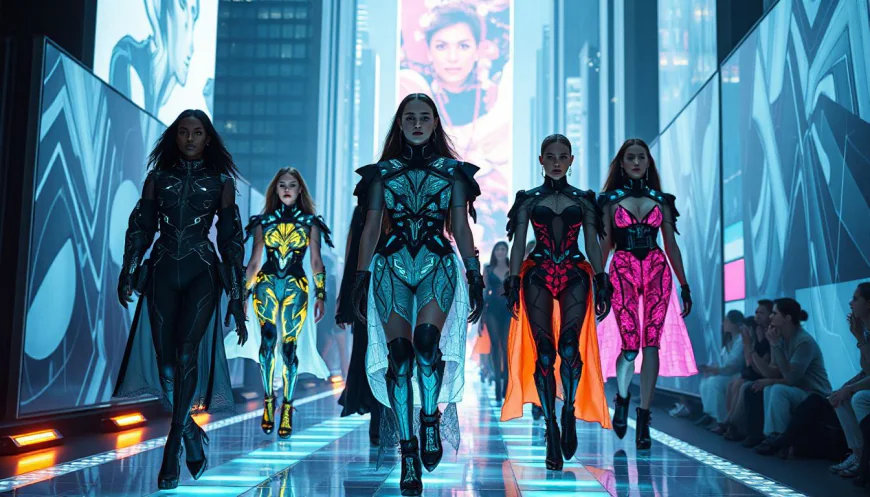Virtual Fashion: The Rise of Digital Couture and NFT Wearables
The way we shop for clothes is changing fast. More than ever, technology is blending with style to create new ways to express ourselves. Virtual fashion is leading this charge—where digital outfits and NFTs are reshaping how we see fashion, ownership, and exclusivity. This new wave isn’t just fun; it impacts everything from how brands connect with fans to how sustainability is improving. As innovation speeds up, the market for digital couture and NFT wearables is growing quickly. It’s a trend you won’t want to ignore

The Evolution of Fashion in the Digital Age
Historical context of digital fashion
Digital fashion didn’t happen overnight. It started with simple 2D sketches, then moved to 3D designs that let designers see clothes on virtual avatars. Eventually, brands began creating full digital collections that exist only online. These outfits are no longer just drawings; they are realistic and customizable virtual pieces.
Technological drivers of digital fashion
New tools like advanced 3D modeling allow designers to craft detailed virtual clothing. Augmented reality (AR) and virtual reality (VR) give people the chance to try on digital outfits online. Blockchain tech, especially NFTs, helps prove ownership and authenticity of virtual wearables, making them more valuable.
Major milestones and industry shifts
Big moments have shaped virtual fashion. For instance, Fortnite collaborated with Balenciaga, showcasing digital skins in a mass-market game. Roblox hosts fashion shows with virtual brands, attracting millions of viewers. These shifts challenge traditional fashion houses while opening doors for newcomers in the virtual space.
Understanding Digital Couture and NFT Wearables
What is digital couture?
Digital couture is high-end, custom-designed virtual clothing. Unlike physical pieces, digital couture lives in online worlds or social media. It allows users to dress their avatars with unique, often one-of-a-kind, digital outfits. Plus, digital couture offers limitless creativity without material limits or production costs.
NFT wearables explained
NFTs, or non-fungible tokens, are digital proof of ownership for virtual items. In fashion, NFT wearables authenticate virtual garments, making them collectible and tradable. Think of NFTs as certificates of authenticity for digital shoes or jackets, which can be bought, sold, or kept forever.
Key platforms and ecosystems
Popular marketplaces include Decentraland, The Dematerialised, and DressX. These sites let users buy and sell virtual clothes with cryptocurrencies. Big brands like Gucci and Balenciaga are jumping in, creating NFT collections and virtual collaborations like Gucci with Roblox or Balenciaga with Fortnite.
Market Trends and Consumer Behavior
Growing consumer demand for virtual fashion
Today’s fashion fans love customization, sharing their looks, and standing out online. Younger audiences especially want exclusive, personalized styles they can showcase on social media or in the metaverse. Virtual fashion fits perfectly with these desires.
Market data and projections
Research shows the virtual fashion market could hit billions in the next few years. Many brands are investing heavily, seeing this as a new way to reach customers. For example, Nike and Adidas are digital-first, launching virtual sneakers and apparel.
Impact on sustainability and supply chain
Digital fashion offers a greener alternative—no waste, no carbon emissions from fabric production or shipping. But some critics question how sustainable digital fashion really is, considering energy use for blockchain and servers. Still, it’s a step toward reducing physical waste.
Benefits and Opportunities for Brands and Consumers
For brands
Creating virtual designs means endless freedom. Brands can test new ideas without costly production. Plus, they can make money from virtual sales and NFTs. This opens fresh revenue streams and builds closer connections with fans.
For consumers
Virtual fashion lets you express yourself totally. Customize your avatar’s outfit, share your look, or own rare digital pieces. It’s often cheaper than physical couture and easier to access anywhere.
Innovative marketing and engagement strategies
Brands host virtual fashion shows, drop limited-edition items as NFTs, or team up with influencers. Some brands use metaverse platforms to connect with global audiences instantly. This makes fashion more interactive and fun.
Challenges and Future Outlook
Technical and ethical considerations
Copyright issues pop up when copying or hacking digital designs. Counterfeit NFTs could flood the market. Plus, concerns about personal data and security are growing as digital fashion spreads.
Industry barriers and limitations
Not everyone owns the tech needed to enjoy virtual fashion. Many brands struggle with creating seamless experiences across different platforms. Standard rules and compatibility are still missing, which can slow growth.
Future trends and potential developments
Look for virtual fitting rooms using AR to go mainstream soon. Artificial intelligence might help design custom digital outfits faster. Experts predict the virtual fashion world will keep expanding, blending into our daily lives.
Conclusion
Virtual fashion isn’t just a new trend—it's a whole new way to think about style and ownership. Digital couture and NFTs are shaping the future of wardrobe choices. For brands, jumping into this space means limitless creativity and new income sources. For consumers, it offers exciting ways to personalize and showcase your digital identity.
Here’s what you can do now: invest in emerging platforms, try limited digital drops, and learn about NFTs. This is just the beginning. As technology improves, virtual fashion will become even more integrated into daily life. The possibilities are endless—get ready to see your wardrobe expand into the digital universe.



 VARSHITHA
VARSHITHA